Eastern Tent Caterpillar
Malacosoma americanum
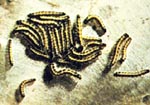
Figure 1. Eastern Tent
Caterpillars on Tent
Description
The adult moth is reddish-brown with two
whitish stripes running obliquely across each forewing. Full grown
caterpillars are generally black and about two inches long. They have a
white stripe down the back and a series of very blue spots between
longitudinal yellowish lines. The larvae are quite hairy.
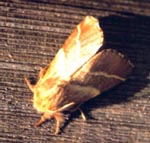
Figure 2. Eastern Tent
Caterpillar Adult
Life History
The insect overwinters in the egg stage in a
distinctive mass attached to the smaller twigs of the host plant. These
masses may be as large as 3/4 inch long and contain 150-350 eggs. They
usually have a varnished appearance. Its favorite hosts include wild
cherry, apple, and crabapple but will feed on ash, birch, black gum, red
gum, willow, witch-hazel, maple, oak, poplar, peach, and plum. In the
spring, when new leaves begin to unfold, the young larvae begin to build
webs in a branch fork or crotch. From these webs, the larva go forth to
feed on the new foliage. When populations are high, complete
defoliation of the tree may occur. After feeding, the larvae migrate to
off-host objects such as fences, tree trunks or other natural or
man-made objects, where they spin silken cocoons. Adults usually emerge
in late June and early July, mate and eggs are laid on twigs. There is
one generation each year.
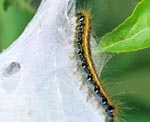
Figure 3. Eastern Tent
Caterpillar Larva on Tent
Damage
Severe defoliation by the eastern tent caterpillar
may occur for several consecutive years. When populations are high,
trees can be completely defoliated putting the tree in a stressed
condition. Fruit trees will bear little or no fruit while ornamental
plants can be weakened leaving them susceptible to secondary agents such
as borers and cankers. Aesthetically, the webs can be quite unsightly
and a general nuisance.
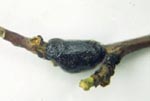
Figure 4. Eastern Tent
Caterpillar Egg Mass on Twig
Nonchemical Control
Eastern tent caterpillars can be
controlled quite effectively by removing webs either by tearing them out
or pruning them out. Removal of overwintering egg masses before spring
will also help reduce natural populations. Various parasites also aid in
naturally reducing populations.
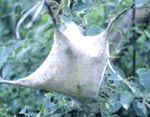
Figure 5. Eastern Tent
Caterpillar Damage
Chemical Control
Tent caterpillars can be controlled by applying insecticidal sprays as soon as the larvae are noticed.